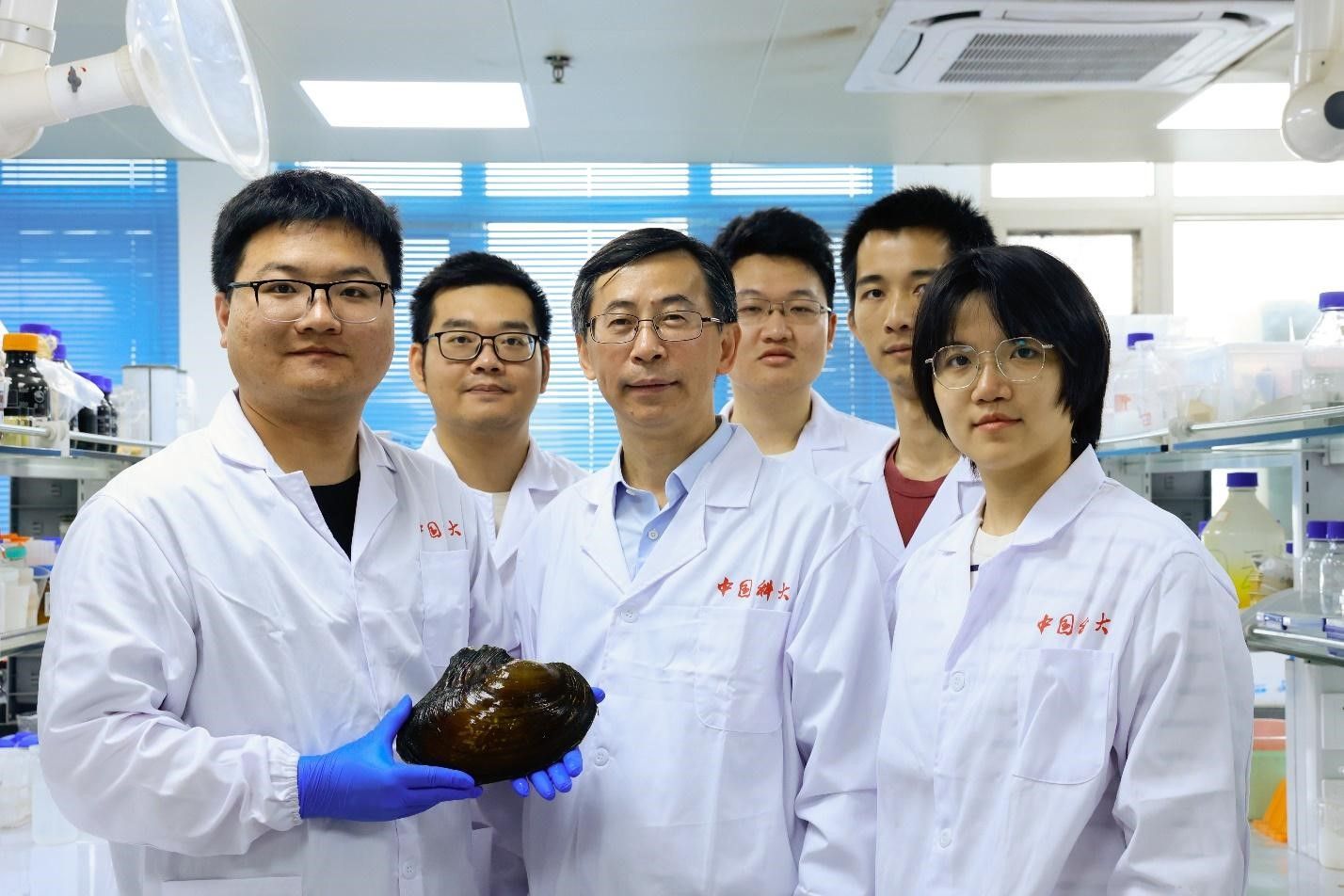Bivalves, such as freshwater mussels, open their shells to feed and reproduce, while closing them tightly to protect their soft bodies from threats from predators such as crabs. Connecting the two valves of every bivalve shell is a hinge, which must flex hundreds of thousands of times across the lifetime of these molluscs.

Professor Shu-Hong Yu (third from the left) and his research team members are showing the bivalve shell Cristaria plicata, also known as cockcomb pearl mussel.
Now, researchers led by Professor Shu-Hong Yu, a materials scientist at the University of Science and Technology of China in Hefei, have revealed the multi-level structures of this hinge down to the nanoscale, showing how it deforms repeatedly without failure. Their findings were published in Science1 and are inspiring new fatigue-resistant, deformable materials.
Extreme fatigue resistance
Fatigue is the accumulation of damage such as tiny microcracks caused by repeated stress over the lifetimes of living organisms or artificial materials. “Fatigue damage is one of the most important factors affecting the service life of materials,” says Yu.
To design robust artificial materials, his team has closely studied rigid biomaterials such as mother-of-pearl, also known as nacre, the inner lining of mollusc shells. Several years ago, while studying the nacre of Cristaria plicata, a freshwater bivalve shell common in China, their interest was piqued by another structure in the shell, the hinge.
Bivalve hinges contain a large fraction of aragonite, a brittle material. “But the hinges are, at the same time, unexpectedly deformable, unlike other relatively rigid biomaterials,” says Yu.
Yu’s team first checked the hinge’s resistance to fatigue. Remarkably, after the team opened and closed the shell 1.5 million times, the hinge showed no signs of fatigue and could still support the shell’s opening-and-closing motions even when the hinge was excessively compressed.

Cross-section of the hinge. The fan-shaped region inside the hinge transfers load between the outer ligament (black line area) and the two valves of the shell.
Hard-soft combination
Next, the researchers examined the hinge’s structure. Shaped like an arch, or semicircle, it has a thick fan-like inner region, lined with a resilient ligament at the outer edge. The fan-shaped region effectively transfers loads between the outer ligament and the two valves of the shell, while avoiding stress concentration from excessive deformation, says Yu.
When the researchers investigated the microstructure of the fan-shaped region, they found long, radially-oriented aragonite nanowires, each about one thousandth the thickness of a human hair. The researchers wondered how these long and brittle nanowires could stand the cyclic deformation of the whole hinge.
At the microscale, they observed that these nanowires are tightly packed in a resilient matrix that wraps around each nanowire. Working with Hengan Wu’s team from the School of Engineering, Yu and his team modelled and analysed the behaviour of this region when compressed or relaxed.
“In this hard-soft composite, the flexible organic matrix absorbs most of the compressive and shear strain during deformation,” explains Yu. “This greatly diffuses the stress within the material and thus protects the nanowires from breaking.”
Twin structures
At the nanoscale, the researchers found that the aragonite nanowires are essentially twinned crystals. This structure can further protect them from bending fracture, says Yu.
The bivalve hinge’s multilevel structures have inspired Yu’s team to design novel deformable and fatigue-resistant materials for applications including flexible electronics. Yu’s team is also keen to study the hinges of other bivalves to see if these hinges rely on distinct structural design principles.
“Bivalves are so diverse, living in different environments and with different habits, that their hinges need to have different mechanical properties,” says Yu. “This could lead to new fatigue-resistant strategies for innovative materials.”
Reference:
1. Meng, XS., et al. Science 380, 1252-1257(2023).
https://www.science.org/doi/10.1126/science.ade2038